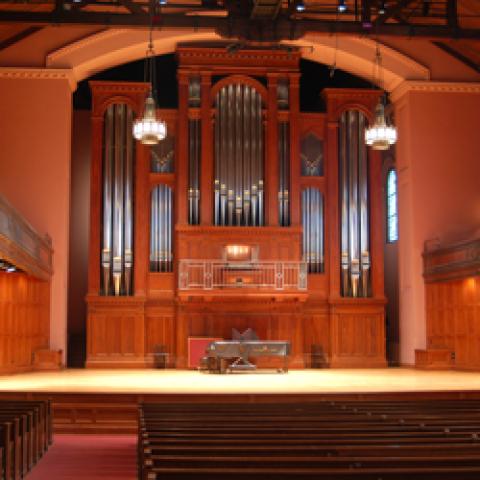FOR IMMEDIATE RELEASE: MEDIA CONTACT: Marci Janas
May 21, 2004 440-775-8328//marci.janas@oberlin.edu
OBERLIN, OHIO -- Oberlin College President Nancy S. Dye has appointed David H. Stull as Dean of the Oberlin Conservatory of Music, effective July 1, 2004. Stull has served as Associate Dean of the Conservatory for four years and Acting Dean of the Conservatory during the spring 2004 sabbatical leave of Dean Robert K. Dodson, who will become provost at the New England Conservatory of Music.
"The appointment of David Stull as Dean of the Conservatory is great news for Oberlin, and has been greeted with unanimous enthusiasm and support by Oberlin’s faculty," says President Dye. "David has a keen understanding of Oberlin's unique place as a top-tier music school and the challenges of the professional music world. The young musicians who study at Oberlin -- and the artists and scholars who teach here -- will find him to be an excellent advocate for their interests and a tireless promoter of their efforts."
Stull brings to his new Oberlin position a wealth of administrative, performance, and teaching experience in music and higher education. During his tenure at Oberlin, he has chaired the Educational Policy Committee for the Conservatory and worked closely with faculty on new initiatives, most recently, the Young Artists and Community Music programs.
Prior to Oberlin, he served as a member of the brass faculty, the Director of Conservatory Admissions, and ultimately as the Assistant Dean of the Lawrence University Conservatory of Music in Appleton, Wisconsin. As Lawrence's Director of Admissions, Stull increased applicants and matriculating students by 60 percent and expanded the school's profile nationally; as Assistant Dean he facilitated the design and implementation of a new curriculum for the Lawrence Conservatory as well as expanded outreach programs for faculty and students. He also cultivated a strong studio of tuba students and coordinated the brass chamber music program, in addition to performing with the faculty brass quintet.
Before his tenure at Lawrence, Stull was Associate Director of Admissions at the Juilliard School, overseeing all aspects of the admissions process and serving as liaison for the Juilliard Opera Center and the Barnard, Columbia, Juilliard exchange program. He also served as Director of Residential Life at the Aspen Music Festival from 1992 to 1994.
A tubist, he has performed with the American Brass Quintet, the Milwaukee Ballet, the Bravo Colorado Music Festival, and the Aspen Festival Orchestra, among others. His performances have included appearances in Lincoln Center's Alice Tully Hall, Town Hall, and Merkin Hall in addition to tours throughout the United States and Europe. He has also recorded for commercial radio and television.
Stull has served as a guest speaker at the Interlochen Arts Academy on numerous occasions, has been a competition judge for Midwest Young Artists and for Juilliard's pre-college division, and has appeared on National Public Radio's Performance Today.
A native of Cincinnati, Ohio, Stull studied tuba with Ronald Bishop at the Oberlin Conservatory of Music, obtaining a bachelor of music degree in performance and a bachelor of arts degree in English literature from Oberlin College. He also pursued further study at the Juilliard School in the American Brass Quintet program and holds a master of music degree from the University of Wisconsin at Madison.
In regard to his new appointment, Dean Stull commented: "I am very pleased and honored to undertake the leadership of the Oberlin Conservatory of Music and I look forward to continuing a legacy of excellence that will grow and flourish in the coming years. This is an outstanding community of performing artists and scholars, and I am privileged to be a part of it."
The Oberlin Conservatory of Music, founded in 1865 and situated within the intellectual vitality of Oberlin College since 1867, is the oldest continuously operating conservatory in the United States. It is renowned internationally as a professional music school of the highest caliber.
Primarily an undergraduate conservatory of music, Oberlin provides its 585 students with unparalleled individual attention and training from more than 85 artist-teachers and scholars. Through hundreds of courses in classical and jazz performance, vocal studies, music history and theory, music education, composition and TIMARA (Technology in Music and the Related Arts), Oberlin has prepared many of the music world's notable luminaries for successful careers in all walks of the profession. Oberlin's collaborations with The Cleveland Orchestra support a core element of Oberlin's mission: that professional training and contact with one of the world's great orchestras is seminal to a formal music education.
For more information about Oberlin, visit http://www.oberlin.edu.
# # #
Marci Janas
Director of Conservatory Media Relations
Oberlin Conservatory of Music
39 West College Street
Oberlin, OH 44074
Tel: 440-775-8328
Fax: 440-775-5457
marci.janas@oberlin.edu
www.oberlin.edu/con



